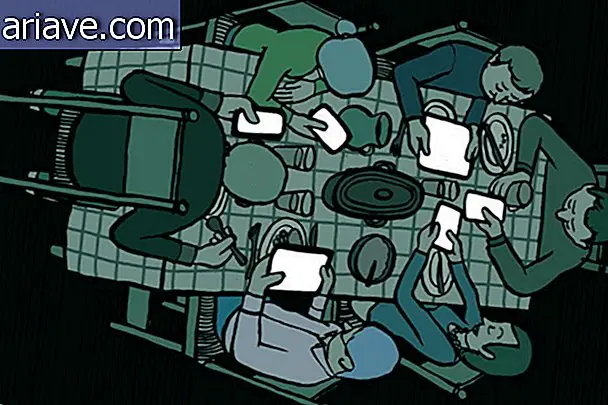6 horrible food and waterborne diseases
You may have had food poisoning, a virus, and even a parasite infection at some point in your life. Although they cause a great deal of discomfort, vomiting and diarrhea, many of these diseases are quickly cured with a light diet and adequate hydration.
However, there are some parasites and pathogenic bacteria that can cause “catastrophic” effects on your body. What is common in all of them is that they are transmitted by contaminated food or water.
This is why it is so important that we exercise the utmost caution with what we eat and drink. If you were already a little careful about this, the items below may make you a little more attentive, which may be great for your health. Check out.
6 - Amoebiasis: Detonates your intestines

Amoebiasis is similar to a “traveler's diarrhea” (which is bacterial, very common in tourists visiting countries like India and Indonesia). However, amoebiasis is much worse. Like diarrhea, you get amoebiasis by eating or drinking something contaminated with fecal material.
This disease is caused by an amoeba called E. histolytica, which enters your digestive tract like a tiny egg. The passage through the acidic environment of the stomach induces its transformation already in the intestine into an amoebic form that quickly divides into eight amoebic trophozoites. At this point, they attack the mucosa lining the organs and may even "dig" the intestinal wall where they begin to secrete enzymes that break down tissue proteins.
Once the intestinal wall is sufficiently dissolved, amoebas feed on the resulting mucus and begin reproduction, spreading the disease more and more. The disease can be mild or extremely painful when the condition gets complicated, accounting for about 100, 000 deaths worldwide. The condition is treated with antibiotics.
5 - Ciguatera: the evil that comes from fish

Ciguatera is a form of food poisoning caused by the consumption of fish that have bioaccumulated ciguatoxin. This substance is produced by a type of plankton called dinoflagellate, which serves as food for other sea beings and fish accordingly.
After eating a contaminated fish, the toxin begins to take effect after two hours, when nausea and cramps begin to appear. Sometimes the intoxication is just that and the person recovers fast. However, if the contaminant has a more susceptible organism, the toxin can migrate to the nervous system, causing dizziness, tingling and shortness of breath.
Tachycardia can also happen, in addition to the general failure of neurological processes. One example of the strangest symptoms this disease causes is a reversal of your perception of hot and cold. What is cold will look like it is burning and vice versa.
4 - Cryptosporidiosis: Erodes the intestines

Cryptosporidiosis is a parasitic infection usually transmitted by contaminated water and unhygienic foods. The disease is caused by the protozoan of the phylum Apicomplexa, genus Cryptosporidium, and lodges in the digestive system. Protozoa enter the body like microscopic cysts that later hatch in the intestines.
There they settle in between the villi - which are like a "forest" of small, finger-like tentacles lining the inside of the gut and absorbing nutrients from food. From this "housing", protozoa begin to erode this tissue, which eventually becomes "smooth", causing severe diarrhea and loss of digestive enzymes.
In people with normal immunity, the disease may have a mild effect, manifesting as gastroenteritis with vomiting and diarrhea, and healing occurs spontaneously. The problem is when the disease attacks people with low immunity, such as those with the AIDS virus. In these individuals, the infection is much more violent and can lead to death.
3 - Salmonella: may even destroy your bones

Who has never eaten a suspicious mayonnaise and then been afraid of getting a beautiful salmonella poisoning? This is one of the best known pathogenic bacteria in the world, being frequent in undercooked foods and eggs. It usually affects the digestive system, causing pain, vomiting and diarrhea, symptoms that last for a few days, but then spontaneous healing occurs with proper treatment.
The biggest problem is when salmonella wants to stroll through your body, leaving the digestive system and migrating to the marrow and bones, causing osteomyelitis. Generally, bacteria target the leg bones, which have a good blood supply.
Once in the bones, a wave of white blood cells arrives to expel the threat and begins to release enzymes that break down the cells into fluid. The result is thick pus pockets where there was bone before. From this effect, salmonella no longer survives in this environment and dies, but leaves a trail of damage.
2 - Cryptococcosis: Fungi In Your Brain

If you already needed a reason to wash the fruits and vegetables before eating them, here is one more. Cryptococcus neoformans is a fungus found worldwide on the earth itself, but is also well known as the pigeon fungus, which is a potential transmitter.
The fungus enters your body through the respiratory system, sending a cloud of basidiospores into your lungs and nasal passages. The disease begins to manifest with a dry cough, followed by fever and some of the most intense headaches of your life. The fungus spreads and releases toxins into the bloodstream.
After a while, the fungus spreads to the central nervous system, creating yeasts along the spinal cord that weave their way to the brain stem. There, the fungus spreads along its meninges, the thin layers of tissue that cover the brain. Thus, the infection affects neurological processes, producing hallucinations, photophobia, nausea and encephalitis.
1 - Trichinosis: may “settle” in their language

Caused by the nematode parasite Trichinella, which most commonly lives in pigs, the disease is transmitted by raw or undercooked pork. After being lodged in the intestines, the larvae of this parasite go into the bloodstream and like to “settle in” on striated muscle cells, such as those in the muscles of the human tongue, where they form colonies.
* Originally posted on 13/01/2014.
***
Do you know the Mega Curioso newsletter? Weekly, we produce exclusive content for lovers of the biggest curiosities and bizarres of this big world! Register your email and do not miss this way to keep in touch!











